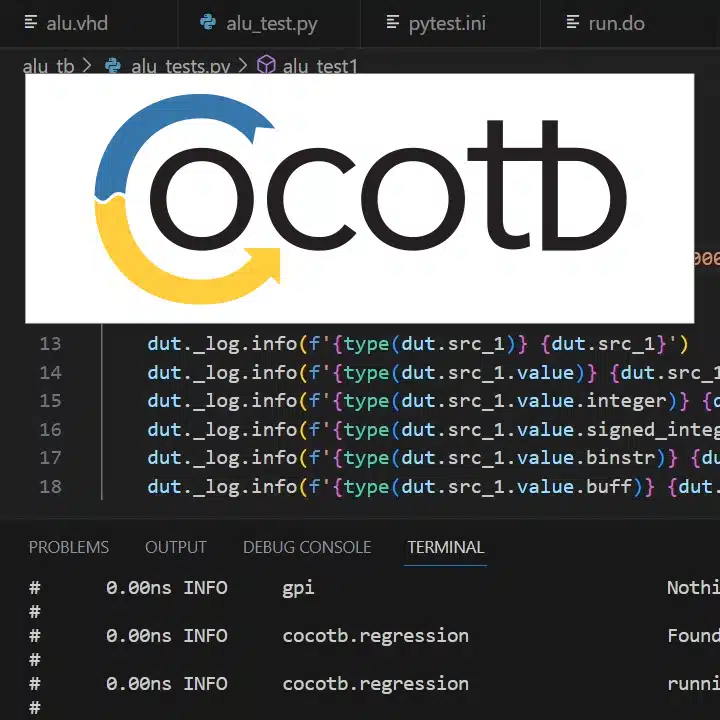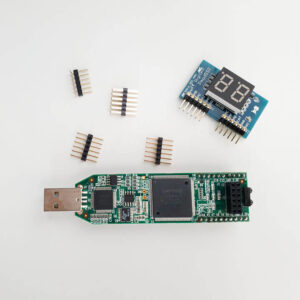Course: Cocotb introduction
Write testbenches in Python for your VHDL design with the Cocotb hardware verification framework. Learn to use Python’s asynchronous constructs in the Questa and GHDL simulators.
Description
Combine the best programming language, Python, with the best hardware description language, VHDL (duh), to write killer testbenches.
Here are some reasons why you should check out Cocotb:
1. Coding efficiency
Python is a high-level programming language with asynchronous features. Writing complex bus functional models or checks in this weakly typed but powerful language may be faster.
Furthermore, you can get help from AI tools like ChatGPT to generate Python functions that work with minimal manual coding. That’s not the case with VHDL because there’s not enough training data on the internet for it to be accurate.
2. Rich ecosystem
Python is the most popular programming language in the world, meaning there are abundant resources to help you get things done fast.
You can easily import and use thousands of third-party libraries, and there are countless help articles in the official documentation and on StackOverflow.
3. Great cross-platform support
Python works equally well on all platforms: Windows, Linux, or MacOS. Furthermore, Cocotb integrates with tools like Makefile or Pytest, making it easy to run regression tests on the complete design.
4. Testbench-DUT decoupling
Using a different language for testing forces you to look at the problem from a new perspective, which can lead to better tests. You might think of corner cases or issues you wouldn’t have considered when only using VHDL, and you are less likely to make the same mistake in two languages.
VHDLwhiz is not affiliated with or endorsed by the Cocotb team.
This course is only available in the VHDLwhiz Membership.
The membership subscription gives you access to this and many other courses and VHDL resources.
You pay monthly to access the membership and can cancel the automatic renewal anytime. There is no lock-in period or hidden fees.
No FPGA board is required as this course is a pure simulation exercise.
Software used in the course
I am using Windows 11 in the course. All the other software is available for free for Windows and Linux:
- Questa – Intel FPGA Edition(includes Starter Edition)
(Any version of ModelSim or QuestaSim will work) - The GHDL open-source VHDL simulator
(Optional. Used in one lesson.) - Windows Subsystem for Linux (WSL)
(Optional. Used in one lesson.) - Microsoft Visual Studio Code
(Any editor will do) - The Cocotb framework
- A Python3 interpreter
- The Pytest Python unit testing tool
Course outline
The overview below shows the lessons in this course.

1 - Introduction
Here's why you should care about Cocotb and what you will learn from this course.

2 - Installing Cocotb on Windows
We'll simulate in Questa and use the Pytest Python testing framework to run regression tests.

3 - Installing Cocotb and GHDL in Windows Subsystem Linux
Let's see how we can run Cocotb in the free GHDL simulator through Makefiles on Linux.

4 - Python corutines and decorators
Cocotb uses Python's async/await coroutines to model and simulate hardware behavior.

5 - Using Cocotb's test runner to compile and run the VHDL simulation
Let's start creating the first Python-based testbench and test case for the ALU module.

6 - Simulating in the Questa GUI
This is how we can make Cocotb open the Questa GUI and load the waveform.

7 - Interacting with VHDL signals from Python
This is how you can read from or write to a VHDL signal from a Cocotb test case function.

8 - ALU behavioral model
For combinational modules, it's easiest to implement the bus functional model as a regular Python function.

9 - ALU test cases
Let's finish the first test case and compare the DUT's and the model's output.

10 - ALU test factory
Cocotb's TestFactory class is a great time-saver for autogenerating test cases based on corner values.

11 - Decoder TB and generic test runner script
We can reuse most of the ALU test runner code when starting on the decoder testbench.

12 - Decoder model Python implementation using AI
We'll use ChatGPT to create the Python code for the behavioral model of the decoder.

13 - Decoder reset test case
To implement this, we need a coroutine to check that the DUT and model outputs match.

14 - Decoder instructions test case
Using the precompiled Hello World program, we can check that the DUT decodes RISC-V instruction words correctly.

15 - Debugging the Cocotb testbench
It may be challenging to debug a Cocotb testbench because it has no signals to view in the waveform, and we can't attach the regular Python debugger.

16 - Singleton behavioral model
Because Cocotb runs the entire testbench in a single simulation, we must ensure that the model remembers its state between the test case runs.

17 - Top-level testbench checking CPU output
This course is only available in the VHDLwhiz Membership.
The membership subscription gives you access to this and many other courses and VHDL resources.
You pay monthly to access the membership and can cancel the automatic renewal anytime. There is no lock-in period or hidden fees.





Reviews
There are no reviews yet.